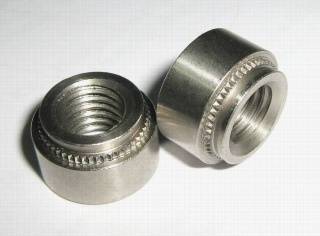So a couple of weeks ago I made 4 more sets of double bollards to match the ones we already have.
I didn't want to weld these on as there is spray foam insulation underneath. This is supposed to be fire resistant but I'd rather not test it and besides it smells when it's burnt by welding. So I've used captive nuts called "clinch nuts".
The serrations grip into and hold on to the metal providing a very tough thread to attach too.
With the holes drilled the bollards were attached with sealant on the mating surface.
Also finished today was the anchor winch. This has been a ongoing project for a while. When I first got it it was a bit of a mess being probably over 70 years old. It was caked in paint and had the wrong chain gypsey for my anchor chain. I had the paint blasted off and to my surprise the body is cast bronze.
I managed to find another gypsey compatible with my chain but the bore was too large so I had a spacing ferrule made. This was all secured to the shaft with a 10mm roll pin.
The winch was missing its wheel. This is not uncommon as the old wheels tend to be cast iron and are easily broken when they are being removed. I was able to get one cast in aluminum by a chap that makes anchor winches.
This is the finished winch.
All that's needed now is another coat of paint.
Something I have to share with you. We will be starting our continental trip Jill & Graham on NB Matilda Rose.
Graham has had some special doggy equipment made. Click the link to see the full story.












The winch and bollards look great. I hope you can remember to 'mind your toes' when walking the side decks in the middle of the night! Good sailing to you.
ReplyDeleteYes I know what you mean. I have considered this and think this is probably the best place for them. In a normal step these will be out of the way. Here's hoping!
DeleteLovely winch Kevin and impressive bollards if I might say...
ReplyDeleteEnjoy you trip. I look forward to reading your and MR's blogs when you get over there.
Bon voyage
Lesley
How exactly these nuts work Kev? and what is the advantage of normal nuts.
ReplyDeleteI thought they were bullocks not bollards. ;-)
ReplyDeleteI do know they are called ferrules not ferals. ;-)
The Yanks call ferrule (ferals) shaft sleeves the infidels. ;-)
Your windlass is a work of art Kev! Very nice indeed. The Admiral will enjoy a great workout cranking that beastie! ;-)
Really looking forward to your adventures on the continent.
Cheers
Rick
Hi Lesley. No doubt you will come visit us in the caravan?
ReplyDeleteThe caravan is long gone Kevin but we will be content to view your travels from the UK ditches for while yet..
DeleteX Lesley
Hello Brian
ReplyDeleteThe advantage is the serrations cut into the base material and re retained so they can be unscrewed if required. Also once they had got a slight bite they are self gripping son no need to have a spanner on the other side to facilitate tightening.